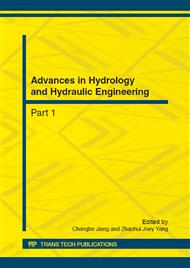[1]
Shen, Z.,Q. Liao,Q. Hong,Y. Gong. An overview of research on agricultural non-point source pollution modelling in China[J]. Separation and Purification Technology, 2012.84(0): pp.104-111.
DOI: 10.1016/j.seppur.2011.01.018
Google Scholar
[2]
Ongley, E.D.,Z. Xiaolan,Y. Tao. Current status of agricultural and rural non-point source Pollution assessment in China[J]. Environmental Pollution, 2010.158(5): pp.1159-1168.
DOI: 10.1016/j.envpol.2009.10.047
Google Scholar
[3]
Bei Rong-ta. Potential Relationship between Soil Nitrogen & Phosphorus Content and Water Pollution in Dianchi Lake [J]. Journal of Northwest Forestry University, 2010.25(2): p.5.(in chinese)
Google Scholar
[4]
Wang, X.,W. Zhang,Y. Huang,S. Li. Modeling and simulation of point-non-point source effluent trading in Taihu Lake area: perspective of non-point sources control in China[J]. Science of The Total Environment, 2004.325(1–3): pp.39-50.
DOI: 10.1016/j.scitotenv.2004.01.001
Google Scholar
[5]
Xie, Y.,Z. Xiong,G. Xing,X. Yan,S. Shi,G. Sun.Z. Zhu. Source of nitrogen in wet deposition to a rice agroecosystem at Tai lake region[J]. Atmospheric Environment, 2008.42(21): pp.5182-5192.
DOI: 10.1016/j.atmosenv.2008.03.008
Google Scholar
[6]
Wilhelm, S.W.,S.E. Farnsley G.R. LeCleir A.C. Layton M.F. Satchwell J.M. DeBruyn, G.L. Boyer,G. Zhu H.W. Paerl. The relationships between nutrients, cyanobacterial toxins and the microbial community in Taihu (Lake Tai), China[J]. Harmful Algae, 2011.10(2): pp.207-215.
DOI: 10.1016/j.hal.2010.10.001
Google Scholar
[7]
van Verseveld, W.J.,J.J. McDonnell,K. Lajtha. The role of hillslope hydrology in controlling nutrient loss[J]. Journal of Hydrology, 2009.367(3-4): pp.177-187.
DOI: 10.1016/j.jhydrol.2008.11.002
Google Scholar
[8]
Öhrström, P.,Y. Hamed,M. Persson,R. Berndtsson. Characterizing unsaturated solute transport by simultaneous use of dye and bromide[J]. Journal of Hydrology, 2004.289(1-4): pp.23-35.
DOI: 10.1016/j.jhydrol.2003.10.014
Google Scholar
[9]
Chaplot, V.,Y. Le Bissonnais. Field measurements of interrill erosion under different slopes and plot sizes[J]. Earth Surface Processes and Landforms, 2000.25(2): pp.145-153.
DOI: 10.1002/(sici)1096-9837(200002)25:2<145::aid-esp51>3.0.co;2-3
Google Scholar
[10]
Bloem, E.,F.A.N. Hogervorst G.H. deRooij. A field experiment with variable-suction multi-compartment samplers to measure the spatio-temporal distribution of solute leaching in an agricultural soil[J]. Journal of Contaminant Hydrology, 2009.105: pp.131-145.
DOI: 10.1016/j.jconhyd.2008.11.010
Google Scholar
[11]
CAI Ming, LI Huai-en, et al Application of modified export coefficient method in polluting load estimation of non-point source pollution [J]. Journal of Hydraulic Engineering,2004(7): p.6.(in chinese)
Google Scholar
[12]
Steenhuis, T.S.,W. Staubitz M.S. Andreini,J. Surface T.L. Richard,R. Paulsen N.B. Pickering J.R. Hagerman L.D. Geohring. Preferential movement of pesticides and tracers in agricultural soils[J]. J. Irrig. Drain. Eng., 1990.116: p.50–66.
DOI: 10.1061/(asce)0733-9437(1990)116:1(50)
Google Scholar
[13]
Jin Ju-liang, Hong Tian-qiu,Wei Yi-ming. Projection pursuit based correspondence factor analysis method of watershed non-point source pollution [J]. Journal of Hydraulic Engineering, 2007.38(9): p.7. (in chinese)
Google Scholar
[14]
Therrien, R.,R.G. McLaren E.A. Sudicky, HydroGeoSphere—a three-dimensional numerical model describing fully-integrated subsurface and surface flow and solute transport in Groundwater Simulations Group. 2007.
Google Scholar


